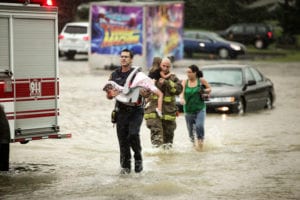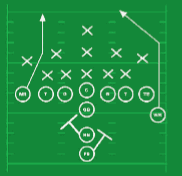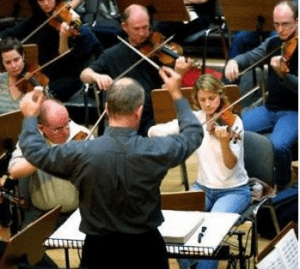 For some public safety agencies it is standard practice for the first arriving personnel (or crews of personnel) to deploy independently. Oftentimes these responders are highly trained, highly motivated and action oriented. What they are lacking is coordination of their efforts.
For some public safety agencies it is standard practice for the first arriving personnel (or crews of personnel) to deploy independently. Oftentimes these responders are highly trained, highly motivated and action oriented. What they are lacking is coordination of their efforts.
The potential problem with this independent action is it may be unrealistic to think multiple individuals (or crews) can arrive at varied times and make the same assessment of the situation/conditions and know, automatically, what other team members are doing and what the goals are they are trying to accomplish. This can cause problems with team and incident situational awareness.
A Play Book
 It is important for responders to have a shared understanding of each member’s role during high risk operations. This complicated task may be easier to accomplish when everyone is trained to a common set of procedures. Standard Operating Procedures (SOPs) or Standard Operating Guidelines (SOGs) can help ensure members understand the performance expectations. Unfortunately, some organizations do not have SOPs or SOGs – they have no playbook. A lack of written Standards does not automatically spell trouble for responders but it is a contributing factor in many casualty investigations.
It is important for responders to have a shared understanding of each member’s role during high risk operations. This complicated task may be easier to accomplish when everyone is trained to a common set of procedures. Standard Operating Procedures (SOPs) or Standard Operating Guidelines (SOGs) can help ensure members understand the performance expectations. Unfortunately, some organizations do not have SOPs or SOGs – they have no playbook. A lack of written Standards does not automatically spell trouble for responders but it is a contributing factor in many casualty investigations.
Rehearsal
 As important as having a play book is practicing the plays. If the organization has written Standards but does not train personnel on how to perform coordinated actions based on the Standards the incident operations are likely to be disjointed and confusing.
As important as having a play book is practicing the plays. If the organization has written Standards but does not train personnel on how to perform coordinated actions based on the Standards the incident operations are likely to be disjointed and confusing.
It cannot be assumed that writing and distributing Standards is going to result in a common understanding of their meaning or a well-coordinated operation.
Coordinated Actions
 In addition to having a playbook and practicing, it is important (and sometimes overlooked) that crews still need to be coordinated. Complex and dynamically changing incidents are commonplace. Incident circumstances often require actions that cannot follow the Standards. The more unique the problem, the greater the likelihood for resilient problem solving.
In addition to having a playbook and practicing, it is important (and sometimes overlooked) that crews still need to be coordinated. Complex and dynamically changing incidents are commonplace. Incident circumstances often require actions that cannot follow the Standards. The more unique the problem, the greater the likelihood for resilient problem solving.
Professional football teams have play books and they practice those plays to perfect their coordination repetitively. Yet the teams still have coaches and coordinators to ensure the members perform in a coordinated way.
To ensure team success, be that a sports team or an emergency response team, someone needs to establish and maintain a big picture view of the field/incident right from the beginning and coordinate the actions of the participants. This is especially important for emergency responders because the participants almost always arrive in a staggered fashion. This is unlike a sporting event where the team members are all present from the start and its easier for the coach to coordinate the actions.
Absent someone to coordinate actions, an incident can degrade as the independent, uncoordinated actions of responders fail to achieve a common goal. The situational awareness at an incident is dependent on the coordinated actions of each team.
Dr. Gasaway’s Advice
 Develop standard operating procedures/guidelines. Practice them as teams, in context to how the team members will perform in realistic environments. Ensure one of the first arriving responders assumes the role of incident commander and coordinates the activities of other responders. The person in charge should maintain a “big picture” view of the incident.
Develop standard operating procedures/guidelines. Practice them as teams, in context to how the team members will perform in realistic environments. Ensure one of the first arriving responders assumes the role of incident commander and coordinates the activities of other responders. The person in charge should maintain a “big picture” view of the incident.
This procedure should allow for some variation for imminent rescue situations. As soon a possible, however, someone needs to assume a role as the coordinator of other incoming personnel. This may be even more important when there is a pending rescue situation because responders get so focused on the rescue that other important tasks can get overlooked. This is where the coordinator can pay off in spades by ensuring all the essential tasks are being assigned and coordinated.

Action Items
1. Discuss the challenges that can arise from engaging in independent actions without coordination.
2. Discuss an incident where independent actions challenged incident coordination and impacted situational awareness of incident personnel.
3. Discuss ideas for how to improve team situational awareness and multiple crew coordination at dynamically changing incidents.

If you are interested in taking your understanding of situational awareness and high-risk decision making to a higher level, check out the Situational Awareness Matters Online Academy.
CLICK HERE for details, enrollment options and pricing.
__________________________________
Share your comments on this article in the “Leave a Reply” box below. If you want to send me incident pictures, videos or have an idea you’d like me to research and write about, contact me. I really enjoy getting feedback and supportive messages from fellow first responders. It gives me the energy to work harder for you.
Thanks,

Email: Support@RichGasaway.com
Phone: 612-548-4424
SAMatters Online Academy
Facebook Fan Page: www.facebook.com/SAMatters
Twitter: @SAMatters
LinkedIn: Rich Gasaway
YouTube: SAMattersTV
iTunes: SAMatters Radio
